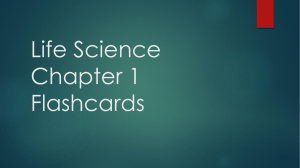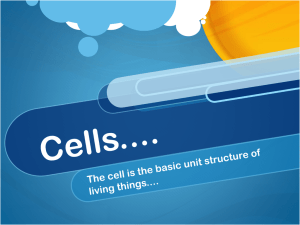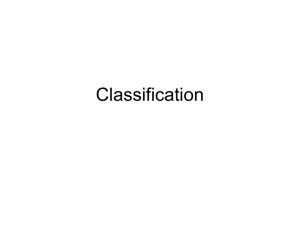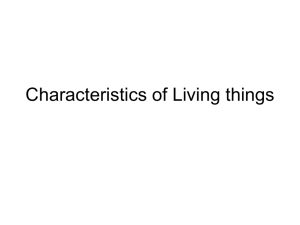Living Things
advertisement
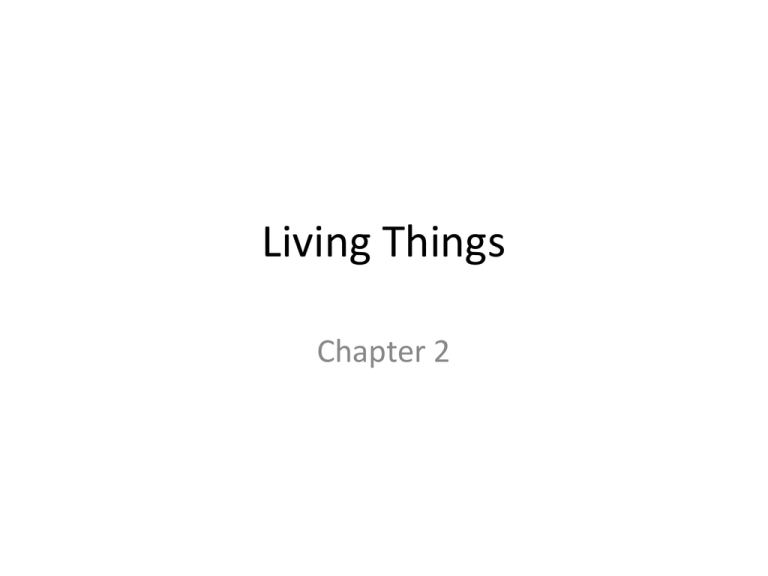
Living Things Chapter 2 What is Life? • Characteristics of living things Cells – _____________ – _______________ Contain Chemicals Use Energy – ______________ Respond to their Surroundings – ________________________ Grow and develop – ________________ Reproduce – ___________ Cellular Organization • Cells - basic unit of structure and function in an organism – microscopic • Unicellular - Single celled (bacteria) • Multicellular- Many cells that are specialized to do certain tasks Example: muscle and nerve cells perform certain tasks in the body to help us move and feel. Chemicals of life water. • Most abundant chemical in cells is__________ Carbohydrates are a cell’s main energy source • ____________ • _______________ Proteins and Lipids are the building blocks of cells. • ___________carry the genetic material, Nucleic Acids chemical instructions that direct the cell’s activities. Energy Use and Response Energy • All cells use ___________to do work such as repair injuries and move chemicals throughout the body • Response _____________________ to Surroundings – reactions to changes in the environment. Example: plant bends toward the light, remove hand from a hot stove. – ________Stimulus change in an organisms surroundings that causes a reaction Response an action or change in behavior – ___________- Growth, Development, and Reproduction • • ______-the process of becoming larger. Growth ____________- process of change that occurs Development to make organisms more complex. • _________________produce offspring that Reproduction are similar to the parents – not exact! Life Comes From Life living things cannot arise • _________________from non-living things through Spontaneous generation - a mistaken idea that ___________________ living things can arise from non-living things Redi Redi’s Experiment • ____________________-helped to _________ disprove spontaneous generation. – Controlled experiment to show that flies do not arise from decaying meat Variable – Manipulated _____________________(Independent Variable) was whether or not the jars were covered to allow the flies to get to the meat inside. – Flies were able to enter the uncovered jars and lay eggs. – The eggs hatched into maggots which developed into flies. – No flies were able to enter the covered jar – no maggots were formed Conclusion – ____________ - rotting meat does not produce flies! Pasteur • ___________-credited with disproving the Louis Pasteur theory of spontaneous generation through his experiment with bacteria and broth. • ______________________Broth Experiment 1. let 2. 3. 4. Clear broth into two flasks with curved necks. The necks oxygen into the broth but were to keep bacteria out. Boiled broth in one flask but not the other Unboiled broth became cloudy showing that new bacteria were growing . Boiled broth remained clear. Conclusion _________________– new bacteria only arise from living bacteria that were already present in the unboiled broth. Needs of Living Things 1. __________ - all living things need water to Water survive. Water is used for breaking down food, growth, transport of nutrients, and reproduction. 2. ____-source of energy to live. Food Autotrophs (self-feeder) – make their own food. 1. ________________________ Example: plants capture suns energy and make their Photosynthesis own food – this process is called ________________. 2. Heterotrophs __________________________ (other-feeder) – obtain energy by feeding on others. Example: animals, mushrooms, and slime molds. Needs of Living Things Continued Living Space 3. ______________-a place to get food, water, and find shelter. The surroundings must provide what the organism needs to live, grow, and reproduce. This sometimes leads to ___________ competition because space is limited on Earth and there are many living things competing for the same space. Stable internal Living Conditions -conditions 4. ___________________________ inside of an organisms body must remain stable even when conditions outside of the body change dramatically. -___________________-maintenance of stable internal Homeostasis conditions Microscope Lab Please Pass the Bread Lab • What factors are necessary for bread molds to grow? – Predict what factors might affect the growth of bread mold – Conduct the experiment – what are the variables? – Collect data through observations recorded on a data table – Analyze and conclude the results – Communicate through a written lab report – Design another experiment based on results Chapter 2-2: Classifying Organisms I. Why Do Scientists Classify? A. Classification is the process Of grouping things based on their similarities B. Biologists use classification To organize living things into groups so that organisms are easier to study C. The scientific study Of how living things are classified is called taxonomy 1. Taxonomy is useful Because once an organism is classified, a scientist knows a lot about the organism II. The Naming System of Linnaeus A. Taxonomy also involves Naming organisms B. In 1750, Carolus Linnaeus devised a system Of naming organisms that is still used today C. Linnaeus placed organisms Into groups based on observable features D. Linnaeus gave each organism A unique, two part system E. This naming system Linnaeus used Is called binomial nomenclature F. Genus and Species 1. The first word In an organisms scientific name is its genus 2. A genus is a Classification grouping that contain similar, closely related organisms 3. A species is a Group of similar organisms that can mate with each other G. Using Binomial Nomenclature 1. A complete scientific name Is written in italics 2. Only the first letter Of the first word is capitalized 3. Scientific names contain Latin Words III. Levels of Classification A. Today’s classification system Uses a series of many levels to classify organisms B. the Major Levels of Classification 1. First, an organism Is placed in a broad group which in turn is divided Into more specific groups 2. The more classification levels That two organisms share, the more that they have in common 3. Eight levels of Classification a. Domain is the Highest level of organization b. Within a domain, There are kingdoms c. Within kingdoms, There are phyla d. Within phyla Are classes e. Within classes Are orders f. Within orders Are families g. Each family contains One or more genera h. Each genus contains One or more species IV. Domains and Kingdoms A. Today, a Three domain system of classification is commonly used B. The three domains are 1. __________________________ Bacteria 2. ___________________________ Archaea 3. ___________________________ Eukarya C. Organisms are placed _________________________________________ Into domains and kingdoms based on their cell type, _________________________________________ their ability to make food, and the number of cells in _________________________________________ their bodies _________________________________________ _________________________ D. Bacteria 1. Members of the domain Bacteria are _______________________________________________________ Are all around you 2. Prokaryotes are _______________________________________________________ Organisms whose cells lack a nucleus a. A nucleus is a ______________________________________________________ Dense area within the cell that contains nucleic acids the chemical instructions that _______________________________________________________ Direct the cell’s activities E. Archaea 1. Archaea can be found _______________________________________________________ In some of the most extreme environments on Earth, _______________________________________________________ including: hot springs, very salty water, swamps, and the intestines of cows • 1. Archaea are Unicellular prokaryotes _______________________________________________________ • 2. Archaea are classified in their own domain, however, because Their structure and chemical makeup differ from that of bacteria _______________________________________________________ _______________________________________________________ • V. Domain Eukarya eukaryotes • A. Organisms in this domain are _____________________ organisms with cells that _______________________________________________________ contain nuclei • B. Scientists classify organisms In domain Eukarya into one of four kingdoms: protists, fungi, _______________________________________________________ plants, or animals _______________________________________________________ _______________________________________________________ C. Protists 1. A protist is any _____________________________________________ Eukaryotic organism that cannot be classified as a plant, animal, or fungus _____________________________________________ _____________________________________________ _________________________________________ a. Some protists are Autotrophs (self-feeders) ______________________, while other protists Heterotrophs (“other feeders) are__________________________________________ b. Most protists are ___________________, but some Unicellular Multicellular organisms ... are large___________________________________ D. Fungi 1. Most fungi are Multicellular eukaryotes _______________________________________________________ 2. A few ... are Unicellular eukaryotes _______________________________________________________ 3. All fungi are Are heterotrophs (other feeders) _______________________________________________________ 4. Most fungi feed by Absorbing nutrients from dead or decaying matter __________________________________________________________ ____________________________________________________ E. Plants 1. Plants are all _____________________________ and most live on Multicellular eukaryotes land _______________________________________________________ 2. Plants are ___________________ that make their own _________ autotrophs food food most heterotrophs on land 3. Plants provide ___________ for ____________________________ F. Animals 1. All animals are Multicellular eukaryotes ______________________________________ ______________________________________ ______ 2. In addition, all animals are Heterotrophs ______________________________________


